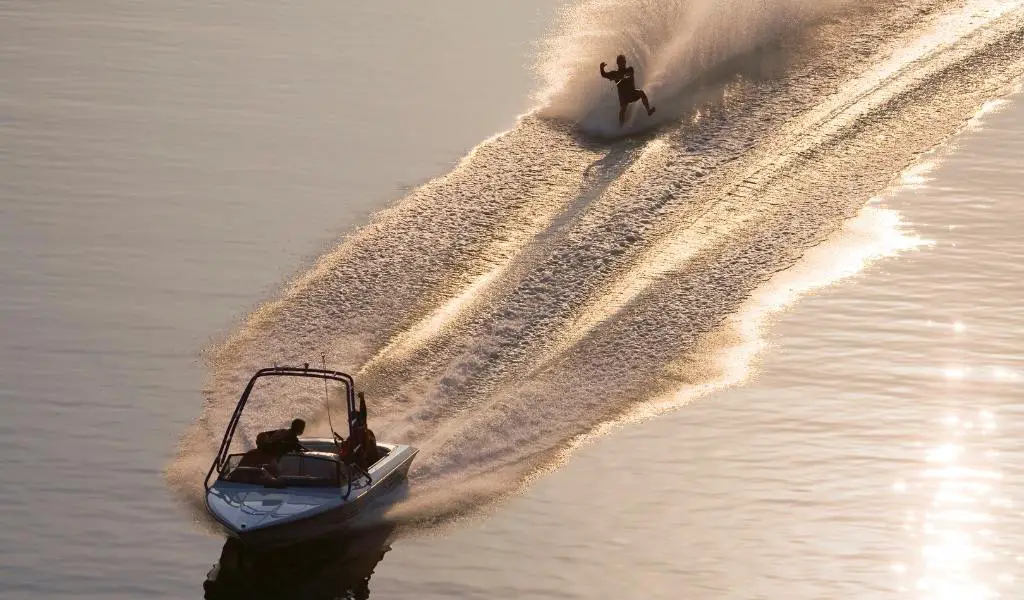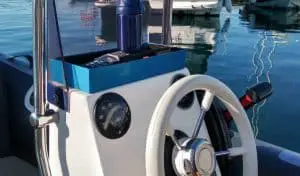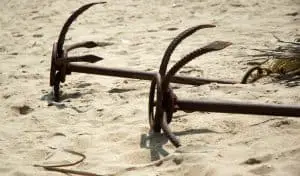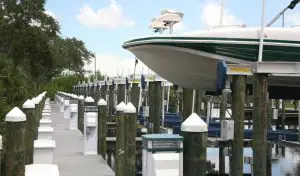Boats come in many different sizes and shapes for any enthusiast. Perhaps no style of boat is more specialized than those designed for water sports. Whether your passion is for water skiing, wakeboarding, tubing, or even wake surfing, there is undoubtedly the perfect boat waiting for you to discover it.
The problem is that all of these sports are somewhat at odds with one another. Water skiing enthusiasts appreciate boats that make a minimal wake. Wakeboarders are looking for waves with big peaks and troughs to jump and do stunts. Unfortunately, the two boats needed to do these two tasks are pretty different from one another.
Inboard Direct Drive Boats
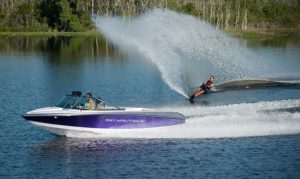
The classic boat for water skiing is a true inboard boat with a direct drive prop shaft. The motor is mounted midships, and the prop is well forward of the stern. The prop wash hits the hull and smooths out the vessel’s wake. Plus, with the engine farther forward, the boat is more balanced than other modern designs, also helping it create a smoother wake.
Having the propeller mounted so far forward offers a valuable safety feature as well. Water sports involve operating close to swimmers in the water. With the prop mounted well inboard and centered on the boat, there is little chance that a swimmer could contact the prop. This is certainly different than inboard-outboard and outboard powered boats that have the props right by the swim area.
Unfortunately, these direct drive inboard sport boats are getting harder and hard to find. Only a few companies make them, and they are made strictly for the purpose of water sports. They don’t cross over into other activities well. The inboard engine takes up a lot of deck space, and the seating areas are designed for watching the action behind the boat.
With such a small market, most sport boat manufacturers have moved onto v-drive designs that are good for wakeboarders too. Direct drive boats can be forced to make a wake, usually by adding tabs or transom wedges. Some owners also add weight to the stern of the boat to force more wake, but this often hampers performance as well.
V-Drive Inboard Sport Boats
V-Drive boats are an interesting design where the engine’s drive system points forward. That way, the engine can be mounted in the back of the boat, freeing up some cockpit and deck space. The motor is then fitted to a v-shaped transmission, which drives a conventional prop shaft that lies near the center of the boat.
With this setup, you get a few of the advantages of a direct drive. The prop is kept away from the edges of the boat, thus keeping swimmers out of harm’s way.
You also get the weight centered farther aft in the boat, which helps generate a little more wake. The engine compartment is usually covered with a padded sunbathing area, which makes an excellent viewing or launch platform for all sorts of water activities.
There are some problems with v-drive boats, though. For one thing, the v-drive system is a lot more complicated than a simple direct drive one. The V-drive and associated equipment take up space in the center of the boat. Servicing these boats is a little more difficult since they have more equipment, and their engines effectively face backward. And all that weight on the back of the boat from the engine can make it more difficult to get on plane.
Whether you choose a direct drive or v-drive design, inboard towboats are incredibly fun to drive. Nothing gets on plane faster than an inboard boat, and they handle like a delight.
Jet Boats
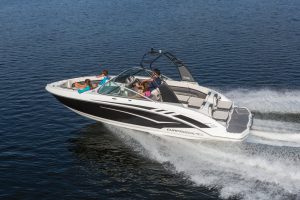
Jet boats are basically grown-up jet skis. They are small sport boats that feature jet drives just like jet skis and wave runners. They get on plane fast, and they can make a big wake if stern loaded. They’re great for water skiing, wakeboarding, and tubing.
There are some disadvantages with jet boats to consider, however. The drive was designed for smaller PWCs, and it really isn’t very efficient on boats. The shallow drive can suck up seaweed and dirt in shallow waters that can damage the impeller. They are also much louder than regular sterndrives or inboard boats. And finally, they can be tough to dock without some practice.
But perhaps most disconcerting for towing sports is that these boats do not make a clean wake. Their wake is usually turbulent and unorganized, leaving a sloppy mess for wakeboarders and skiers. The pull on the tow rope makes these boats swing off course, requiring more corrections from the helmsman and an even sloppier wake.
It should be noted that inboard sport boats and jet boats are designed for protected waters. They are perfect for inland lakes and rivers, or very protected bays on calm days. They have low freeboards, and their small size makes them unsuitable in steep seas. If you’re looking for an ocean-going vessel, you’ll probably need a very large inboard or something in the sterndrive category.
Inboard/Outboard Designs
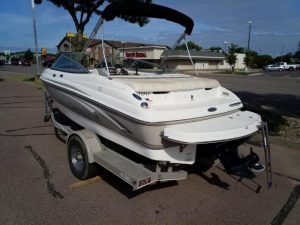
An inboard/outboard, or I/O design, the engine sits in the very stern of the boat and is coupled to a drive leg similar to the lower unit of an outboard. This setup is also known as a sterndrive.
Having the engine aft frees up cabin and deck space for storage and guests, but it also moves a lot of weight aft. Sterndrives have a few advantages over true inboard boats. For one thing, their thrust is generally directly aft and therefore more efficient than inboards or v-drives, which have the prop angled downward slightly.
One of the greatest advantages of these boats is that the lower unit can be trimmed, just like an outboard boat. This can help get the boat on plane faster, especially helpful when towing. This makes water skiing easier and more enjoyable
Outboard Boats
Outboard boats are very popular and come in a lot of designs. Cabin cruisers and sport boat manufacturers are just tuning into the outboard game, and they are gaining popularity due to their cross over abilities. Handling wise, they operate nearly identically to sterndrive models.
By moving the engine outside of the boat, a lot of space is saved that can be used for seating, fuel, or storage. But all of that weight is moved even farther aft than on an I/O boat. This also means that these boats will generally make an even bigger wake.
Both I/O and outboard boats have the propellers located right near the swim platform. Operators must take the utmost care to ensure the engine is off when swimmers are in the water. Towing sports operators need to be extra cautious approaching their swimmers, and also being careful not to foul their props in slack tow lines.
Perhaps the most significant disadvantage of outboard motors for water sports is the lack of a proper swim platform. Many models have the engines mounted on a bracket that doubles as a platform, which can be adequate though still awkward.
Outboards have many advantages, however. Servicing them is usually quick and easy, as is replacing an entire engine if it’s ever necessary. Outboard boats come in pretty much any design you like, but you will find more boats that can perform other tasks as well. They’ll be perfectly adequate for tubing or skiing, but you can find one that will take the family fishing or cruising too.
Neither I/O nor outboard boats are appropriate for water skiing or wake surfing. Wake surfing requires the sportsman to be too close to spinning propellers to accomplish safely with stern-mounted props.
How and Where Are You Going to Use Your Boat?
What vessel you choose comes down to what sort of activities you’d like to accomplish in your boat. If you’re a water skier and that’s all you want to do, the choice is pretty clear. You’ll want an inboard boat, and probably a direct drive one. If you or your friends also wish to wake board or wake surf, you might look into v-drive options.
Being honest with yourself is important, and you’ll need to take a close look at what you want to do with the boat. If you want to head offshore, or partake in other watery activities like fishing, cruising, or sandbar hopping, you might want to take a look at stern drive boats. Truly, very few people by a sport boat to use as a pure ski towing vessel.
Versatility and extra amenities available in crossover models shouldn’t be overlooked. Does the boat come with factory options for towing? Ski towers are a great addition since they place the tow line at the pivot point of the boat. They also provide storage for toys when out of the water, and are a great place to mount stereo speakers or other nautical novelties. Can the seat layout be changed easily so that it is appropriate for cruising or skiing?
Size, weight, and performance will all be factors in your decision. No matter the type of boat, the smaller boat will always cost you less to keep and maintain properly over the long haul. Smaller boats with higher power loading also mean faster hole shots and better towing experiences.
Conclusion
Whether shopping for a sport boat for your home lake or looking at ocean-crossing trawlers, one thing is always true in boating. All boats represent a compromise in one form or another. You can get the perfect ski boat with a direct drive inboard. But in doing so, you give up versatility to use the boat in other situations. Will choosing the task-specific boat reduce your overall use and enjoyment of the boat?
Articles you may be interested in:

